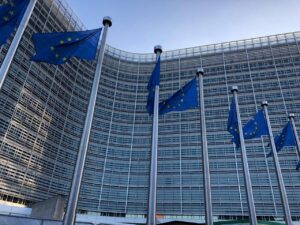The Americans warn the companies involved in Nord Stream 2 against sanctions. It is unclear whether they will decide to introduce them, against some of the Europeans involved in the project. This threat is likely to increase the cost of the gas pipeline. Meanwhile, today there will be a significant vote on the revision of the Gas Directive, which may potentially delay its implementation – writes Wojciech Jakóbik, editor-in-chief of BiznesAlert.pl.
The gun is hanging on the wall
The US declaration of readiness to impose sanctions on Nord Stream 2 waits in store for companies that are financially involved in this project, as a gun on the wall in a theatre play. It is not a foregone conclusion that it will succeed, but the declaration itself can increase the cost of loans to Gazprom.
The Countering America’s Adversaries Through Sanctions Act (CAATSA) provides for the possibility of sanctioning companies that may participate in the construction of the Nord Stream 2 gas pipeline – said Heather Nauert, Secretary of State of the United States, in an interview with a journalist from TVP. This is a gas pipeline from Russia to Germany through the Baltic Sea with a planned annual capacity of 55 billion cubic metres, which could be built by the end of 2019. Supporters are counting on cheap gas, and critics are afraid of increasing Russia’s influence, weakening the potential of alternative projects, slowing down market development, relativising the EU law, threatening security in the Baltic Sea and failing to meet environmental standards.
The administration of President Trump explains the slow pace of implementation of the provisions of the law by, among others, protests from EU states, including Austria and Germany, which fear that the introduction of the sanctions provided for in the CAATSA law on the energy sector in Russia may hit German and Austrian companies implementing projects in this sector of the Russian economy with a ricochet. Therefore, BiznesAlert.pl’s thesis that Americans hesitate due to opposition of some European allies against sanctions is confirmed.
– We made it clear that (foreign companies – PAP) which cooperate with the Russian gas pipeline construction sector, may be affected by CAATSA sanctions – said Nauert quoted by the PAP. This is all possible if sanctions come into force. However, a source of BiznesAlert.pl close to Polish-American talks argues that by threatening to do so, banks are likely to overestimate the risks associated with their investment in the Nord Stream 2 gas pipeline. This means that loans for a 100% Gazprom project may increase, with the project cost currently estimated at €9.5 billion. This is bad news for the lenders: the German E.on/Uniper and BASF/Wintershall, the French ENGIE, the Dutch-British Shell and the Austrian OMV. The latter’s CEO, Rainer Seele, said in September that once implemented, the sanctions would make Nord Stream 2 funding „almost impossible.” The threat of sanctions will make them more expensive. In autumn, Seele announced that, in the worst-case scenario, the financial partners would put their money out of their own resources.
A solution in Europe increasingly close to completion
Today, 21 March, the European Parliament’s Committee on Industry, Research and Energy (ITRE) will vote on the draft report of Professor Jerzy Buzek on the revision of the Gas Directive proposed by the European Commission. Projects such as Nord Stream 2 may be subject to the law due to the regulation. Like the threat of U.S. sanctions, the revision will not block this project, but may delay it by bringing it into line with antitrust rules. Russia would be able to fulfil them, for example by allowing an additional company to export. However, this would require a change in Russian law, and previously lengthy negotiations with the European Commission. It is not clear whether Russia will agree to this. If not, in theory the Commission could block the project for non-compliance with European rules, as was the case with South Stream.
In March, Germany was to give its consent for the gas pipeline to run through its exclusive economic zone. For the time being, it is agreed to go through territorial waters. It is not known whether and when the second one, without which the construction will not be able to start, will be awarded. As long as it is not launched, the proposal can be made subject to the revised gas directive, which is intended to cover new projects.
It is worth noting, however, that the opposition of Nord Stream 2’s defenders in the European Council, led by Germany, may jeopardise the Commission’s project, which is supported by Poland, some Central and Eastern European countries and, according to the declaration of the Commissioner for Strategic Energy Infrastructure, southern countries such as Italy, precisely because they expect a similar decision on Nord Stream 2 to be taken after South Stream has been rejected.
Pressure sometimes works
Interestingly, pressure from threats of US sanctions and EU regulations may be effective. The fact that the European Union refused financial support for the Balkan branch of the Turkish Stream pipeline from Russia to Turkey could have been the reason for the project’s capacity reduction. The Russians report that they will dismantle part of the supporting infrastructure, the Russian Southern Corridor, to reduce Turkish Stream’s capacity from the originally planned 63 to 31.5 billion cubic meters per year. It means that Gazprom will build two rather than four Turkish Stream pipelines. The second is still uncertain due to the lack of a partner to build a branch in the Balkans. The risk of the Commission blocking this project may deter potential applicants, and without financial support from the EU, the Balkan countries may also lack money. To cover up this fact, Gazprom met with the Italian Ambassador to Russia and ENI to discuss Turkish Stream’s supplies to Europe, but after the meetings there were no concrete developments other than press releases presented as successes in the Russian media.
I repeat a thesis that I have already articulated many times in the media. Nord Stream 2 will be difficult to block. However, a shotgun of US threats and EU regulations is hanging on the wall and, even if it does not shoot, it is putting obstacles in the way of those who want to build a new gas pipeline from Russia, despite the continuing occupation of the Crimea and attempts to kill European Union citizens, for which the Kremlin regime is probably responsible.








